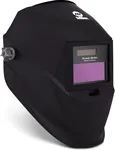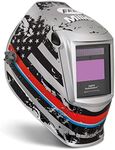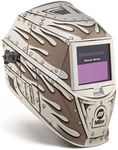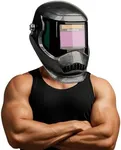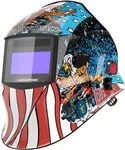Buying Guide for the Best Miller Welding Helmets
Choosing the right welding helmet is crucial for ensuring safety, comfort, and efficiency while working. A welding helmet protects your face and eyes from the harmful effects of welding, such as sparks, UV radiation, and intense light. When selecting a welding helmet, consider the key specifications that will best suit your needs and preferences. Here are some important factors to consider:Lens ShadeLens shade refers to the darkness of the helmet's lens, which protects your eyes from the bright light produced during welding. This is important because it prevents eye strain and damage. Lens shades are typically rated from 5 to 13, with higher numbers indicating darker shades. For general welding tasks, a shade of 10 to 13 is recommended. If you are working with lower amperage or doing tasks like grinding, a lighter shade may be suitable. Choose a lens shade based on the type of welding you do most frequently.
Auto-DarkeningAuto-darkening helmets automatically adjust the lens shade based on the intensity of the welding arc. This feature is important because it allows you to see clearly when the helmet is in the up position and provides instant protection when you start welding. Auto-darkening helmets come with different reaction times, typically measured in milliseconds. Faster reaction times (e.g., 1/25,000 of a second) offer better protection and comfort. If you frequently switch between welding and other tasks, an auto-darkening helmet can be very convenient.
Viewing AreaThe viewing area is the size of the lens through which you see while welding. A larger viewing area provides better visibility and can make it easier to see your work from different angles. Viewing areas typically range from 6 to 9 square inches. If you need to see a wide area or work in tight spaces, a larger viewing area can be beneficial. Consider the size of the projects you work on and your need for visibility when choosing the viewing area.
Comfort and FitComfort and fit are crucial for long welding sessions. A helmet that fits well and is comfortable to wear can reduce fatigue and improve productivity. Look for adjustable headgear, padding, and lightweight materials. Helmets with multiple adjustment points allow for a more customized fit. If you spend a lot of time welding, prioritize comfort features to ensure you can work efficiently without discomfort.
WeightThe weight of the helmet affects how comfortable it is to wear for extended periods. Heavier helmets can cause neck strain and fatigue, while lighter helmets are easier to wear for long durations. Helmets typically range from 1 to 2 pounds. If you do a lot of overhead welding or work for long hours, a lighter helmet can be more comfortable. Consider the weight in relation to the duration and type of welding you do.
DurabilityDurability refers to how well the helmet can withstand the rigors of welding. A durable helmet will last longer and provide consistent protection. Look for helmets made from high-quality materials like polycarbonate or nylon. If you work in harsh environments or handle your equipment roughly, a more durable helmet is essential. Consider the conditions in which you work and choose a helmet that can withstand them.
Safety StandardsSafety standards ensure that the helmet meets certain criteria for protection. Look for helmets that comply with ANSI Z87.1 standards, which cover impact resistance, optical clarity, and other safety features. Ensuring your helmet meets these standards is important for your safety. Always check for certification labels and choose helmets that adhere to recognized safety standards.
